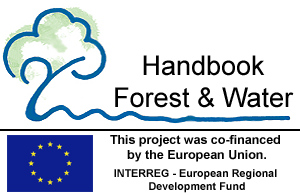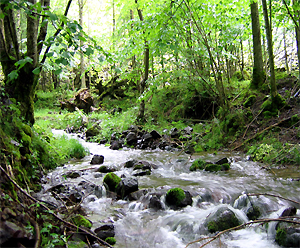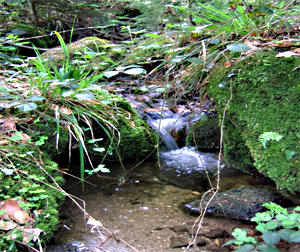


Fig. 1+2: Silica rich coarse material of low mountain ranges – above the Netzen stream in Alsace and below the Reichen stream in the Northern Black Forest.
Reference rivers for good ecological condition
The Forest Research Institute (FVA), under the framework of an Interregional-Project, in partnership with Switzerland and France, researched the ecological condition of small forest streams. Following the guidelines of the Water Framework Directive (WFD) of the EU, all streams are to brought up a good ecological condition by 2015 (see information above).
Aim of the Water Framework Directive:
The main goal of the WFD is the prevention of further deterioration, as well as the protection and improvement of aquatic ecosystem conditions and the directly dependent terrestrial ecosystems and wetlands with respect to their impact on water supply. Secondary goals are the good condition of surface waters (good ecological and chemical condition), the good condition of ground waters (good chemical and amounts) and an adequate water supply in the land- or wetland- dependent ground or surface waters. Good condition is defined as a condition which only marginally differs from a very good condition. Very good condition is that with no, or only very few, observable changes from that normally associated with the absence of interfering anthropogenic influences.
Reference streams describe the very good, respectively good, condition of different types of water courses.
Prior studies by the Baden-Württemberg Regional Office of the Environment, Measurement and Nature Conservation meant that reference river stretches would predominantly be in forests. This meant, as far as possible, semi-natural water courses, that also displayed good hydro-morphological condition, would be located in forests (hydro-morphological describes the actual conditions of a watercourse). The reference conditions can be carried out on a spatial-orientation or model basis or a combination. The spatial orientation approach to reference conditions is derived from real watercourse stretches which represent good or very good ecological condition with regard to their morphology, water quality and flow conditions along with their inhabitants. The Interregional-Project chose the spatial-orientation approach. Following criticism on this choice standards for the reference stretches (in Germany) were determined as:
1. Reference watercourses should reflect as near to natural conditions as possible. Therefore only stream reaches which according to the forest biotope map are at least partly semi-natural and exhibit a typical, for the stream, forest community (> 0,1 ha) can be included in the final choice, these are
- Stichwort-Blackalder Riparian Forest (Stellaria-Alnetum glutinosae)
- Greyalder-Riparian Forest,(Alnetum incanae), special form
- Blackcherry-Alder-Ash Forest (Pruno-Fraxinetum)
- Blackalder-Ash Forest (Carici remotae for silica streams, Carici elongatae for carbonate streams)
2. The watercourse reaches should be at least 300m long
3. and occur in a state forest, so that protection and development measures can eventually be implemented afterwards.
4. The actual choice should take place via an on-site survey which follows the choice of the French side as much as possible. Two reference rivers were determined for every area of unspoilt nature
- For the northern Blackforest valley the Reichenbach and the Wernest stream
- For the middle Blackforest the Kahler Bach and the Sulzbach,
- For the southern high Blackforest the Schwöbenenbach and the Mettma Stream.
On the French side:
- For the variegated sandstones of the northern Vosges the Tiefenbach,
- For the variegated sandstones of the high Vosges the Netzenbach and the Fallbaechel,
- For the Alsation Jura the Lucelle, as boundary river with Switzerland and
- For the foothills of the Vosges the Petite Fecht, the Strengbach and the Ehn.
The reference water courses were also subject to influences and disturbance which affected the good ecological condition and therefore limited or made impossible the passability of the watercourse for water-bound creatures. This structure of the reference watercourses would be evaluated according to the method developed by the FVA (EStruKa). Additionally the water quality, macro-zoobenthic community and occurrence of fish fauna were examined. The results were documented and their characteristics described in reference to the qualitative factors of the EU-WFD. There was also a description of the vegetation and local observations of the floodplain or 25m strip of land on either side of the watercourse. The short description and documentation was recorded on a so called watercourse leaflet, which was based on the existing LAWA-leaflet (see explanation to the leaflets). These leaflets documented by means of different observations the good ecological condition and helped assess the development goals of the heavily modified water courses with which they were compared.
The reference rivers chosen and described by the FVA and the accompanying data are case studies for forest streams with good ecological conditions and also for those varying from it. They are stretches of water in which it can be shown that the forest industry influences the ecological condition of water courses.
Literature
Kern, K. & T. Fleischhacker (2005): Naturnahe Fließgewässer in Baden-Württemberg – Referenzstrecken. Reihe: Oberirdische Gewässer, Gewässerökologie, Bd. 96, LfU Baden-Württemberg, Karlsruhe.
Pottgiesser, T. Sommerhäuser, M.: Vorläufige Steckbriefe der deutschen Fließgewässertypen (Stand: Februar 2004).
Downloads
You can download the translated leaflets about the reference water courses as PDFs here:
